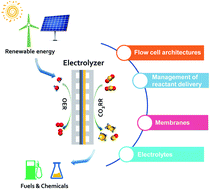An overview of flow cell architecture design and optimization for electrochemical CO2 reduction
Abstract
Converting CO2 into value-added fuels or chemical feedstocks through electrochemical reduction is one of the several promising avenues to reduce atmospheric carbon dioxide levels and alleviate global warming. This approach has mild operating conditions, adjusts product distribution, allows modular design, and offers opportunities for carbon-intensive manufacturing industries to utilize renewable energy power for CO2 reduction. In recent decades, various valid methods and strategies have been developed for high efficiency and high selectivity electrocatalysts to reduce CO2. Unfortunately, while intensive research focuses on the development of new electrocatalysts, little attention has been paid to the engineering design of low-cost and large-scale CO2 reduction electrolyzer architectures, which impairs the full realization of potential benefits of new electrocatalysts. This review summarizes the recent progress of reactor architectures and system engineering in the CO2 reduction reaction. We discuss how to improve the performance of the CO2 reduction reaction from four aspects: (i) flow cell architectures, (ii) management of reactant delivery, (iii) membranes, and (iv) electrolytes. We aim to introduce reactor architectures and system engineering strategies in detail to enable further development and provide inspiration for potential industrial applications of CO2 reduction.



 Please wait while we load your content...
Please wait while we load your content...